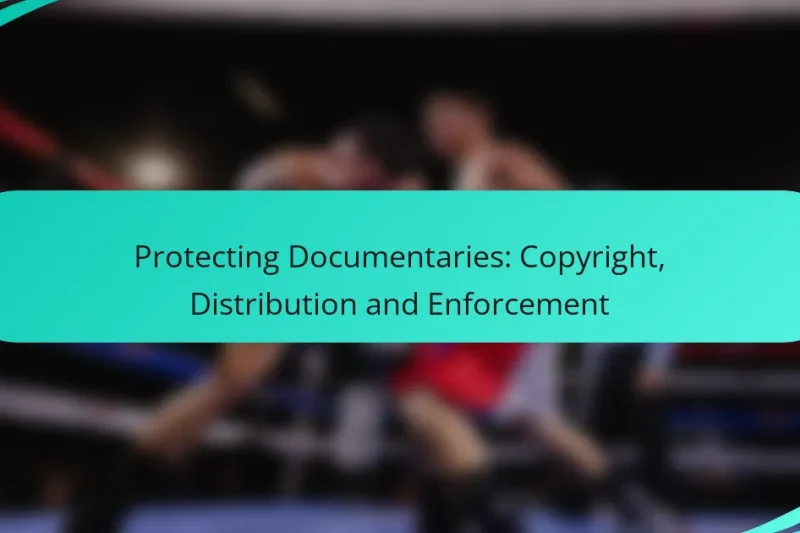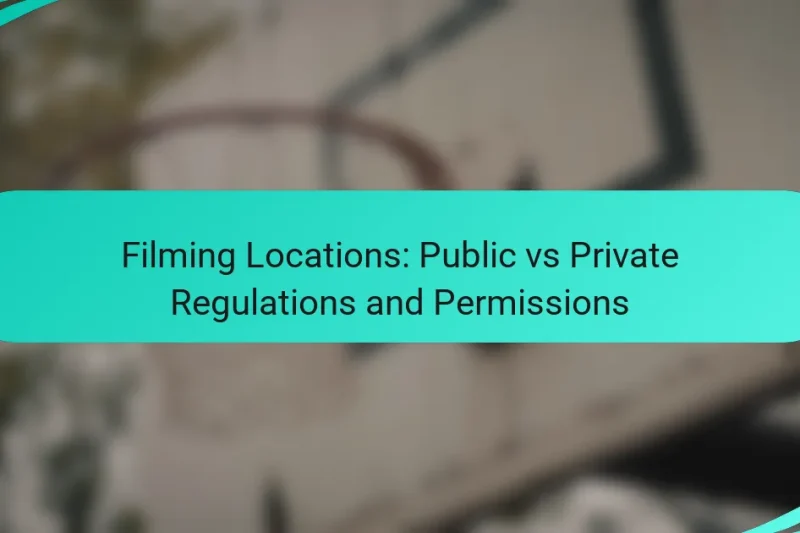Protecting documentaries through copyright law is essential for filmmakers, as it secures their original content and … Protecting Documentaries: Copyright, Distribution and EnforcementRead more
Extreme Sports Documentary Production: Legal Considerations
Extreme sports documentary production presents unique legal challenges that filmmakers must address to ensure compliance and protect their interests. Key considerations include liability waivers, insurance, permits, and intellectual property rights, all of which are essential for a successful and lawful production. By carefully navigating these legal requirements, filmmakers can focus on capturing the thrilling essence of extreme sports while minimizing risks and ensuring participant safety.
Liability Waivers: Protection, Compliance and Risks
Liability waivers are essential tools for businesses in the US, designed to limit legal responsibility for … Liability Waivers: Protection, Compliance and RisksRead more
Licensing Options: Music Rights, Costs and Alternatives
Understanding music licensing options is essential for anyone wishing to use music legally, whether for commercial … Licensing Options: Music Rights, Costs and AlternativesRead more
Filming Locations: Public vs Private Regulations and Permissions
Filming in various locations involves navigating a complex landscape of regulations and permissions, which differ significantly … Filming Locations: Public vs Private Regulations and PermissionsRead more
What are the legal considerations for extreme sports documentary production in the US?
Extreme sports documentary production in the US involves several legal considerations that filmmakers must navigate to ensure compliance and protection. Key areas include liability waivers, insurance requirements, permits, intellectual property rights, and release forms for participants.
Liability waivers
Liability waivers are essential for protecting filmmakers from legal claims arising from injuries during filming. These documents should clearly outline the risks associated with the extreme sports being filmed and require participants to acknowledge and accept these risks. It’s advisable to consult with a legal professional to ensure waivers are enforceable in the relevant state.
Insurance requirements
Obtaining adequate insurance coverage is crucial for extreme sports documentary production. Filmmakers should consider general liability insurance, which can cover accidents and injuries, as well as equipment insurance to protect against loss or damage. Depending on the nature of the stunts, additional coverage such as production insurance may also be necessary.
Permits and location agreements
Filming in public spaces or private properties often requires permits or location agreements. Filmmakers should research local regulations and apply for the necessary permits well in advance to avoid fines or interruptions. Location agreements should outline terms of use, including access times and any compensation for property owners.
Intellectual property rights
Understanding intellectual property rights is vital when producing a documentary. Filmmakers must ensure they have the rights to use any music, footage, or images that are not their own. Licensing agreements should be secured for any third-party content to avoid copyright infringement issues.
Release forms for participants
Release forms are necessary to obtain consent from participants featured in the documentary. These forms should specify how the footage will be used and grant permission for distribution. Clear communication about the project and its potential reach can help participants feel comfortable signing these agreements.
How to manage risks in extreme sports documentaries?
Managing risks in extreme sports documentaries involves thorough planning, assessment, and adherence to safety protocols. By identifying potential hazards and implementing effective safety measures, production teams can minimize the likelihood of accidents and ensure a safer filming environment.
Risk assessment strategies
Effective risk assessment strategies begin with identifying all potential hazards associated with the specific extreme sport being filmed. This includes evaluating environmental factors, equipment safety, and participant experience levels. Conducting a thorough analysis helps in prioritizing risks based on their likelihood and potential impact.
Utilize tools like risk matrices to categorize risks into low, medium, and high levels. This visual representation aids in focusing resources on the most critical areas. Regularly updating the risk assessment throughout the production process is essential, as conditions and participant capabilities may change.
Safety protocols for filming
Establishing safety protocols is crucial for protecting cast, crew, and equipment during filming. This includes mandatory safety briefings for all participants, outlining the risks involved and the measures in place to mitigate them. Ensure that all crew members are trained in first aid and emergency response procedures.
Implementing equipment checks before each shoot is vital. Use safety gear appropriate for the sport, such as helmets, harnesses, and pads. Regularly inspect and maintain filming equipment to avoid malfunctions that could lead to accidents.
Emergency response planning
Emergency response planning is a critical component of risk management in extreme sports documentaries. Develop a clear plan that outlines the steps to take in case of an accident, including communication protocols and evacuation routes. Ensure that all crew members are familiar with the plan and conduct drills to practice the response.
Identify local emergency services and establish a direct line of communication with them. Having a designated safety officer on set can streamline the response process and ensure that all safety measures are followed. Always have first aid kits and emergency supplies readily available on location.
What are the best practices for obtaining permissions?
Obtaining permissions for extreme sports documentary production involves securing the necessary legal approvals to film in specific locations. This process typically includes acquiring location permits, negotiating with landowners, and understanding local regulations to ensure compliance and avoid legal issues.
Securing location permits
Securing location permits is crucial for filming in public or private spaces. Start by identifying the relevant authority that oversees the area where you plan to shoot, whether it’s a national park, city, or private property. Applications should be submitted well in advance, often requiring details about the filming schedule, crew size, and equipment used.
Be prepared to pay permit fees, which can vary widely depending on the location and duration of the shoot. For instance, filming in a national park may cost hundreds of dollars, while a city permit could range from a few dozen to several thousand dollars, depending on the complexity of the shoot.
Negotiating with landowners
When filming on private property, negotiating with landowners is essential. Approach landowners early in the planning process to discuss your project and its benefits, such as potential publicity or financial compensation. Clearly outline how the filming will be conducted and any measures you will take to minimize disruption.
Consider drafting a written agreement that specifies the terms of use, including access times, compensation, and liability coverage. This protects both parties and ensures clarity on expectations, which can help prevent disputes during or after filming.
Understanding local regulations
Understanding local regulations is vital for compliance and safety during filming. Research any specific laws that apply to extreme sports, such as safety standards, insurance requirements, and environmental protections. Local governments may have unique rules regarding filming in certain areas, especially if they involve wildlife or protected lands.
Consult with local authorities or legal experts to ensure you are aware of all necessary regulations. This proactive approach can save time and resources, as failing to comply with local laws can lead to fines or even the halting of your production.
How to protect intellectual property in documentaries?
Protecting intellectual property in documentaries involves securing rights to original content and ensuring that your work is legally safeguarded against unauthorized use. Key strategies include copyright registration, trademark considerations, and understanding the fair use doctrine.
Copyright registration
Copyright registration is essential for documentary filmmakers to protect their original works, including scripts, footage, and music. In the United States, registration with the U.S. Copyright Office provides legal advantages, such as the ability to sue for damages in case of infringement.
To register, complete an application form, submit a copy of the work, and pay a fee, typically ranging from $35 to $55. It’s advisable to register your work as soon as it is created to establish a clear ownership timeline.
Trademark considerations
Trademarks protect brand names, logos, and slogans associated with your documentary. If your film has a unique title or branding, consider applying for trademark protection to prevent others from using similar identifiers that could confuse audiences.
To secure a trademark, conduct a search to ensure your desired mark is not already in use, then file an application with the United States Patent and Trademark Office (USPTO). This process may take several months and involves fees that can range from a few hundred to over a thousand dollars.
Fair use doctrine
The fair use doctrine allows limited use of copyrighted material without permission for purposes such as criticism, comment, news reporting, teaching, scholarship, or research. In documentary filmmaking, this can apply to using clips from other works under certain conditions.
Factors influencing fair use include the purpose of use, the nature of the original work, the amount used, and the effect on the market value of the original. It’s crucial to assess these factors carefully, as fair use can be subjective and may require legal consultation to navigate effectively.
What insurance options are available for extreme sports productions?
Extreme sports productions require specialized insurance options to mitigate risks associated with high-adrenaline activities. Key insurance types include general liability, equipment, and production insurance policies, each addressing specific aspects of potential liabilities and losses.
General liability insurance
General liability insurance protects against claims of bodily injury or property damage that may occur during filming. This coverage is essential for extreme sports, where accidents can happen unexpectedly, leading to significant financial repercussions.
When selecting a policy, consider coverage limits that reflect the risks involved. For extreme sports, limits often start in the low six figures, but higher coverage may be necessary depending on the activity and location.
Equipment insurance
Equipment insurance covers damage or loss of production gear, which can be particularly vulnerable in extreme sports settings. This type of insurance is crucial for protecting expensive cameras, drones, and other specialized equipment used in filming.
Evaluate the value of your equipment and choose a policy that covers replacement costs. Many producers opt for policies that include coverage for theft, accidental damage, and even loss during transport.
Production insurance policies
Production insurance policies encompass a range of coverages tailored for film and television projects, including extreme sports. These policies can include elements like cast insurance, location insurance, and weather insurance, which are vital for managing the unique challenges of outdoor filming.
When considering production insurance, assess the specific risks associated with your project. Policies can vary widely in cost, often starting in the low thousands of USD, depending on the scope and scale of the production.
What are the ethical considerations in extreme sports documentaries?
Ethical considerations in extreme sports documentaries revolve around the safety and rights of participants, as well as the portrayal of the sport itself. Filmmakers must balance the thrill of extreme activities with the potential risks and the impact on those involved.
Participant consent
Obtaining informed consent from participants is crucial in extreme sports documentaries. This means ensuring that individuals fully understand the risks associated with their involvement and agree to be filmed in potentially dangerous situations.
Filmmakers should provide clear information about the nature of the activities, possible hazards, and how the footage will be used. A written consent form is often recommended, detailing the rights of the participants and the scope of their involvement.
Common pitfalls include assuming verbal consent is sufficient or failing to disclose specific risks. Always ensure that participants are aware of their right to withdraw consent at any time without penalty.



